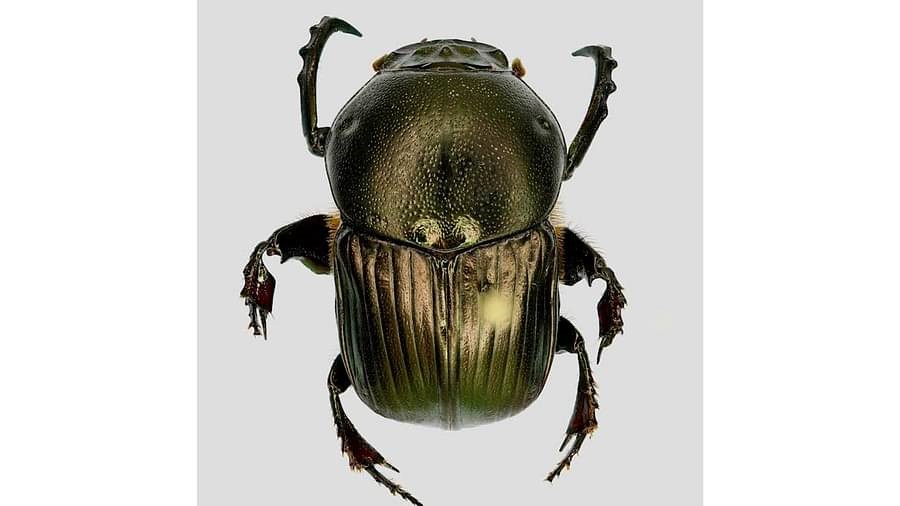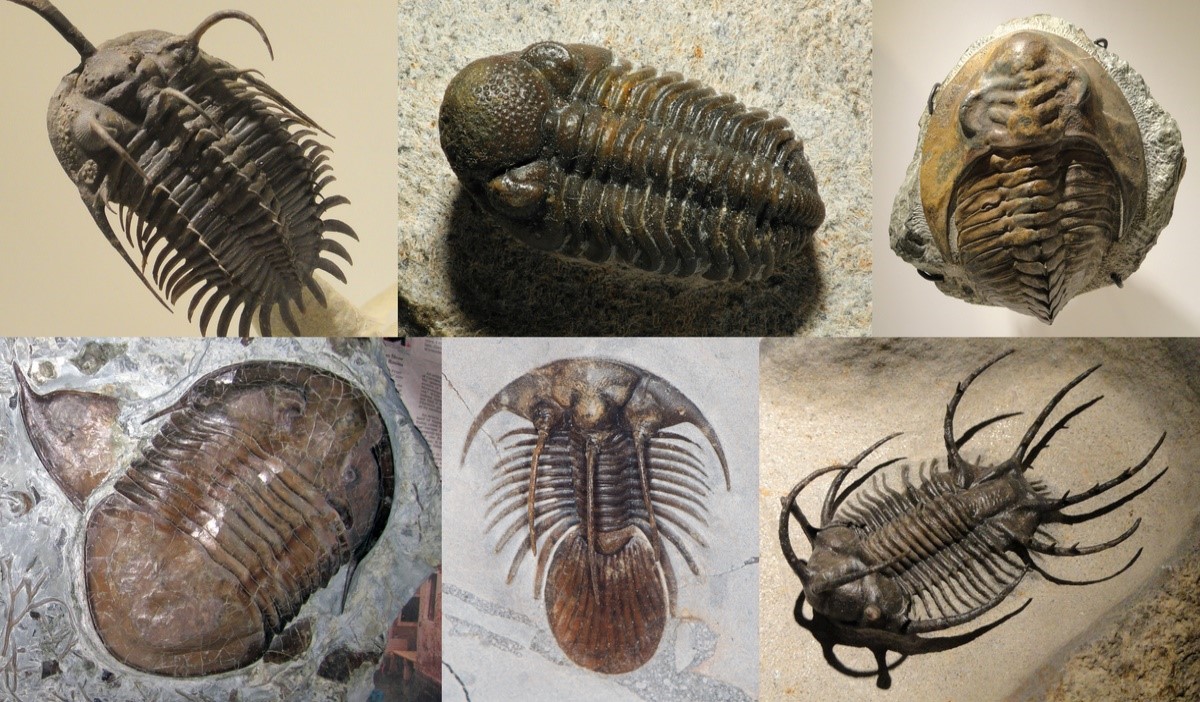Onitis visthara
Entomologists from the Ashoka Trust for Research in Ecology and the Environment (ATREE) recently discovered Onitis visthara in the Hesaraghatta grasslands in northwest Bengaluru.
- It is a new species of dung beetle of the genus Onitis.
- Nomenclature - Onitis visthara is named for its relatively broader appearance (visthara is breadth in Kannada).
- Family – Scarabaeidae
- Onitis - Onitis is a relatively rare genus of dung beetles found in the Afrotropical, Oriental, and Palaearctic regions.
Only 176 species of Onitis had been reported globally, before the discovery of the new species.
- Onitis species are tunnellers, they bury large quantities of cattle dung beneath the dung pat to provide food for their larvae.
- It process and decompose cow dung by feeding, breeding, and nesting in it.
- Cattle dung is a major source of greenhouse gas emissions and contributes significantly to climate change.
An average cow produces approximately 30 kg of dung daily, amounting to over 10 tons per year with India having the world’s largest livestock population, exceeding 535 million heads.
- Additionally, these beetles enhance nutrient cycling, improve soil aeration, aid in secondary seed dispersal, and help control parasites.

- Other species - The team also discovered 2 other new species
- Onitis Kethai - Biligiri Rangaswamy Temple Tiger Reserve, Karnataka, and
- Onitis Bhomorensis -Tezpur, Assam.
- Nomenclature
- Kethai is named after the entomologists’ field assistant late Ketha Gouda and
- Onitis bhomorensis after the bridge Kolia Bhomora across Brahmaputra, from where the new species was collected.
|
Hesaraghatta Lake
|
- Hesaraghatta Lake is a humanmade reservoir located in the north-west of Bengaluru, Karnataka.
- It is a fresh water lake created in the year 1894 across the Arkavathy River to meet the drinking water needs of the city.
- The lake was part of 'Chamarajendra Water Works' project designed by then chief engineer of Mysuru, MC Hutchins, during the tenure of Dewan K Seshadri Iyer.
|
References
- Deccan Herald | New Dung Beetle Species discovered
- The Hindu | New species of dung beetle discovered
- Hindustan Times |3 new species of dung beetles discovered
Port Blair renamed as Sri Vijaya Puram
Union Minister recently said in a post on X that Port Blair will now be known as ‘Sri Vijaya Puram’.
- Port Blair - Port Blair is the capital of the Union Territory of Andaman and Nicobar Islands and the entry point of the Andaman and Nicobar Islands.
- It was named after Archibald Blair, a naval surveyor and lieutenant in the Bombay Marine. He was the 1st officer to carry out a thorough survey of the Andaman Islands.
- Archibald Blair’s survey mission - He joined the Bombay Marine in 1771, set out on a survey mission along the coasts of India, Iran, and Arabia.
- He had participated in a number of survey missions, including those in the Chagos archipelago, Diamond Harbour located in the south of Calcutta, and along the Hooghly River in late 1780s.
- In December 1778, Blair left for his first surveying voyage to the Andamans from Calcutta, along with 2 ships, Elizabeth and Viper.
- The expedition, which lasted till April 1779, took him around the west coast of the island, thereby sailing north along the eastern coast he reached the natural harbour which he initially named as Port Cornwallis.
- Later the island was renamed after him. Blair wrote a detailed report of his survey, which was received very positively by the East India Company (EIC) officials.
- Soonafter, the EIC decided to colonise the islands, mainly to establish as a safe harbour from which it could check the activities of the Malay pirates.
- The island was also to serve as a refuge for shipwrecked people and a place where their officers could take shelter in case of hostilities with other powers.
- With several convicts being transported to the islands to serve unpaid labour, the island soon became a penal colony.
- In December 1792, however, the colony was shifted to the north east part of Andaman to the newly established Port Cornwallis for purely strategic reasons.
- But the new colony could not sustain for too long on account of severe disease and death there. The EIC stopped operating it in 1796.
- Revival of the colony after 1857 revolt - The Revolt of 1857 resulted in a large number of prisoners for the British, prompting the immediate renovation and resettlement of Port Blair as a penal colony.
- Most of the convicts received life imprisonment at Port Blair. Several of them were hanged, while many died due to disease and the degrading conditions in the region.
- Kaala pani - With the strengthening of the Indian Independence Movement in the late 19th century, a huge cellular jail was established here by 1906.
- Popularly known as Kaala Paani, it housed several freedom fighters, including Veer Damodar Savarkar.
- Meanwhile, Blair had already returned to England in 1795 and is known to have read an account of the Andaman Islands before the Royal Society of London in 1799.
- Connection with the Cholas- Some historical records suggest that the Islands were used as a strategic naval base by the 11th century Chola emperor, Rajendra I to carry out an attack on Srivijaya, which is in present day Indonesia.
- As per an inscription found at Thanjavur dated to 1050 CE, the Cholas referred to the island as Ma-Nakkavaram land (great open/ naked land), possibly led to the modern name of Nicobar under the British.
- The name Sri Vijaya Puram pays homage to the ancient Sri Vijaya Empire, which held influence over the region.
- The Andaman and Nicobar Islands hold a prominent place in India’s fight for independence.
- It is also the place that hosted the first unfurling of our Tiranga by Netaji Subhash Chandra Bose ji.
- And also the cellular jail where Veer Savarkar ji and other freedom fighters struggled for an independent nation.
Reference
The Indian Express | Port Blair renamed as Sri Vijaya Puram
Bharat Start up Knowledge Access Registry (BHASKAR)
The Department for Promotion of Industry and Internal Trade (DPIIT), Ministry of Commerce and Industry is set to launch the Bharat Startup Knowledge Access Registry (BHASKAR).
- Aim – It is designed to bring together a diverse array of stakeholders ranging from entrepreneurs and government bodies to investors and academic institutions onto a single, integrated platform.
- Ecosystem Stakeholders

- The initiative is under the Startup India program.
- Objective - To build the world’s largest digital registry for stakeholders within the startup ecosystem.
- Vision - To foster collaboration and accelerate growth and cross-collaboration within the entrepreneurial community.
- Key Features
- Networking and collaboration- Bridges gaps between startups, investors, mentors, and other stakeholders for seamless interaction.
- Centralized access to resources- Provides immediate access to critical tools and knowledge for faster decision-making and scaling.
- Personalized identification- Assigns unique BHASKAR IDs to each stakeholder for personalized and tailored platform interactions.
- Enhanced discoverability- Powerful search features for easy location of relevant resources, collaborators, and opportunities.
- Supporting India’s global brand- Facilitates cross-border collaborations to promote India as a global hub for innovation.
- Impact on India's Startup Ecosystem- It will serve as a central hub for startups, investors, service providers, and government bodies to collaborate and accelerate growth.
- It will also unlock the potential of India's startup ecosystem, fostering a resilient and innovation-driven economy.
Reference
PIB | Bharat Startup Knowledge Access Registry
Trilobite species
A recent study reveals that fossils of a trilobite species from upstate New York show an additional set of legs under its head.
- Trilobite- They are extinct marine arthropods that form the class Trilobita.
- It forms one of the earliest known groups of arthropods.

- Anatomy- It has bodies segmented into a head, thorax, and tail.
- The head region is composed of several fused segments, with appendages serving various functions such as sensing, feeding, and locomotion.
- Finding- The finding suggests that having a 5th pair of head appendages might be more widespread among trilobites than previously thought.
- The newly recovered Triarthrus eatoni fossils revealed an additional leg, resolving the mismatch between the counting methods.
- Comparisons with the trilobite Olenoides serratus revealed that the trilobite head had 6 segments i.e. one with the eyes, one with antennae, and four with walking legs.
- Methodology- Traditionally, trilobite head segments are counted by examining grooves (furrows) on the exoskeleton or by counting preserved antennae and legs.
- There is often a mismatch between these two methods due to the rarity of soft appendage preservation.
References
- The Hindu | Trilobite species
- Britannica | trilobite
Typhoon Yagi
Super Typhoon Yagi, one of Vietnam's strongest storms in 30 years, struck northern and central regions of the country.
- Journey- After passing through Hainan Island in China, Tropical Cyclone Yagi intensified into a super typhoon and made landfall in Quang Ninh province and Hai Phong City, Vietnam.
- Impact- It has become the most powerful storm in Asia in 2024 and severely impacted countries including the Philippines, China, Laos, Myanmar, Thailand, and especially Vietnam.
Typhoon yagi is the 2nd most powerful storm globally in 2024 after Hurricane Beryl.
Formation of Tropical Cyclones
- Conditions- Form over warm ocean waters near the equator.
- Process- Warm, moist air rises, creating a low-pressure area.
- Warm ocean temperatures - Tropical cyclones form in tropical oceans with sea temperatures of at least 27°C.
- Low pressure - Areas of low pressure form over the warm ocean waters, drawing in surrounding winds.
- Converging winds - Winds near the ocean surface converge, forcing air to rise and form storm clouds.
- Low wind shear - Winds do not vary greatly with height, allowing storm clouds to rise vertically.
- Distance from the equator - The cyclone is far enough from the equator for the Coriolis force to take effect and cause the cyclone to spin.
- Surrounding high-pressure air moves into this low-pressure zone, also becoming warm and moist, then rises to form clouds and thunderstorms.
- Classification- The strength of tropical cyclones is categorized using the Saffir-Simpson Hurricane Wind Scale into five categories based on sustained wind speeds.
The Saffir–Simpson hurricane wind scale is based on the highest wind speed averaged over a one-minute interval 10 m above the surface.
Climate Change and Tropical Cyclones
- Impact- There is a consensus that rising global temperatures are making tropical cyclones more intense.
- Study findings- Tropical cyclones in Southeast Asia are forming closer to coastlines, intensifying more rapidly, and lingering longer over land.
- Sea surface temperature- Global mean sea surface temperature has increased by 0.9°C since 1850 and by 0.6°C in the last four decades.
- Effect- Higher sea surface temperatures cause marine heat waves, escalating the intensity of storms with stronger winds, heavier rainfall, and increased flooding.
Reference
Indian Express | Typhoon Yagi


